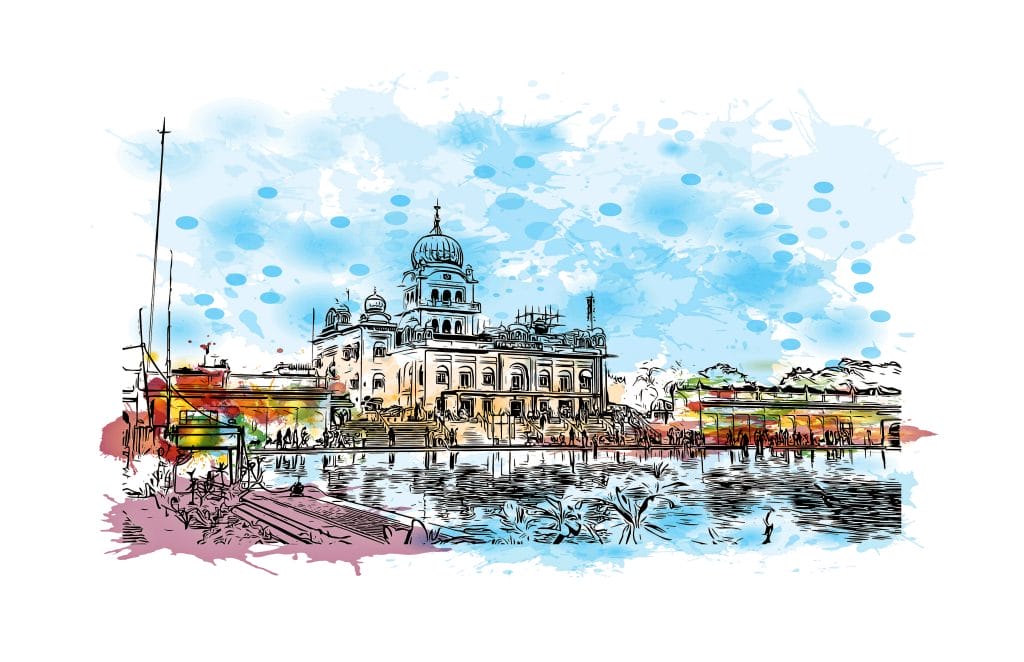Dolly Koghar reminisces about how the Gurudwara has and always will be her lodestone.
Recently, I’ve been reflecting that unlike before, the Songkran of today is now a time when tourists from across the continents brave the heat of April and come together here in good ol’ Thailand to be sprayed with water, left, right, and centre, from one-usage toy guns to buckets of water from merrymakers on pickup vans. Lately, it’s also been an enticing excuse to come and partake of the extensive, and recently-legalised, marijuana options.
The Songkran of yore, or to us North Indians, the harvest festival of Vaisakhi, wasn’t a long-extended holiday, but just the one day when the whole of Bangkok, including our Punjabi Sampheng community, headed en masse for a fun-filled trip to Bang Saen beach. In hindsight, I wonder if darjee was really having fun splashing and wading in the tepid water, or was he mentally back at Punjab Store, which wasn’t just a shop, but our identity; it was who we were! The journey to own it had been a long and arduous journey; one that started at the onset of the 1900s when papaji, his dad, along with a handful of other Hindu and Sikh Punjabis migrated from their homeland of Gujranwala, a part of Punjab in today’s Pakistan and landed on the blessed shores of Siam, then under the reign of the benevolent King Rama V of the Chakri dynasty.
These forefathers settled into communes in and around the present-day Phahurat, which remains a hubbub for everything and anything Indian. They built a Gurudwara as its core centre, which always has four entrances welcoming everybody and anybody. We go there, and matha-taek, touch our foreheads before our holy book, the Guru Granth Sahib Ji, and supplicate Waheguru for a life of honesty and one of selfless service; seva to the One creator and His creation.
The existing Sikh temple with the golden dome in Phahurat sits exactly on the earlier homey one, but it also ate up the early Sikh school, which was open to the general public, as well as the concrete ground dividing it from the Gurudwara. It was this basketball-sized ground where we did our pre-wedding milnees and where the huge, standing cameras captured the photos of the guests; starting with the gents. The groom would sit in the centre with his immediate family with the rest of the male guests standing against the stairway leading up to the classrooms, and sometimes, if the list was long, then on the steps also. Then it was the turn of the female relatives, but without the bride. She would await her cue to join the groom seated before the Guru Granth Sahib Ji around which they would both take four solemn and beautiful lawaa to the backdrop of a melodious kirtan. The hymns from the scriptures would be sung by our ragees, accompanied by harmoniums and the twin hand-drums, bongo look-alikes, the tablas.
The bride would be dressed in a red salwar-kameez with gold tila, shimmering gold thread work; demurely hiding her makeup-free face under her ghoonghat; her dupatta drawn low over her face and waiting in a relative’s home in any of the three communes around the original Gurudwara. One was where my maternal grandparents lived, at the end of an alley that divided the Gurudwara and its adjacent Sikh school, its main entrance was where the present Nai Lek Chai Dee is. Then there was Pitoolek Lek; the small iron-gated community, which has stood the test of time and modernisation and exists almost as it was, only with its original iron gate usurped by a vegetable vendor. The neighbouring Pitoolek Yai, the big iron gated commune entrance has given way to The Indian Emporium, and the weaving maze of Indian shops and restaurants behind it, was once two rows of two-story co-joined homes where my life and that of many of my age began.
Despite these changes, the Gurudwara remains a place where our expanded Indian community of any religious affiliation gather for solace in losses and bereavements, and to express our gratitude for the blessing of a newborn; it’s there we are reminded that we are but part of a whole, part of the One Creator, that has made us all equally capable of becoming divine.







